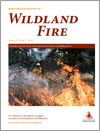International Journal of Wildland Fire
Volume 27
Number 1 2018
This study defined and mapped the interface areas of Canada. The wildland–urban interface was found to cover 32.3 million ha (3.8% of total national land area). Two novel interface types were also mapped: the wildland–industrial interface (10.5 million ha; 1.2% of land area), and the infrastructure interface (109.8 million ha; 13.0% of land area).
Simulation modelling showed that an unrealistically large-scale prescribed-burning program across Tasmania would be necessary to reduce wildfire extent and intensity under dangerous fire-weather conditions. By contrast, more feasible, but geographically constrained, broad-scale prescribed-burning plans had substantially reduced effects on area burnt and fire intensity. This study highlights the need for targeted localised fuel treatments rather than broad-scale prescribed burning.
In the frame of vegetation fire modelling, numerous studies allow proper prediction of the behaviour of dead fuel. However, these models fail to capture the behaviour of living fuel. Hence this study aims to model the behaviour of living fuel through the specific role of sap, which seems to drive the fuel temperature during the heating phase leading to ignition.
Two years following prescribed fire in upland forests of the Southern US, stem mortality of 10 deciduous broadleaved species ranged from 7 to 59%. Stem size was inversely related to the probability of stem mortality (P(m)) whereas maximum bole char height was positively related to P(m) for all species examined.
The evolution of two linear fires that merge forming a small angle is analysed based on laboratory and field-scale experiments. The observed strong fire acceleration and deceleration are explained by changes of the induced flow and the fire geometry regardless of the scale and boundary conditions of the fire.
Bird communities were most diverse following tundra fire at sites with a moderate degree of burn damage compared with unburned or severely burned sites. The number of individuals present was also greatest at moderately burned sites.




